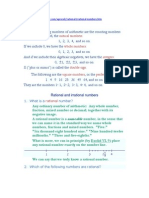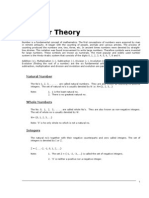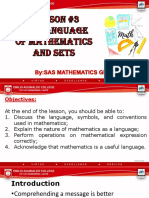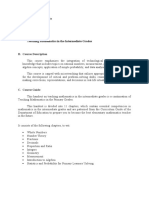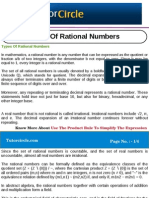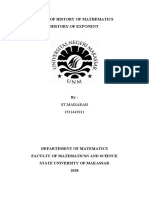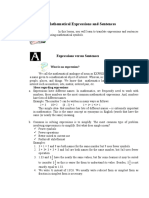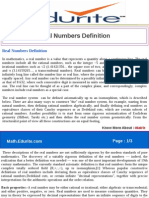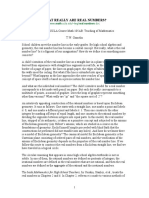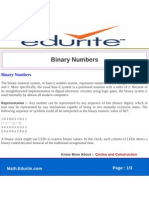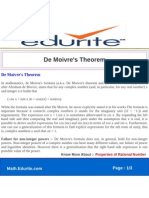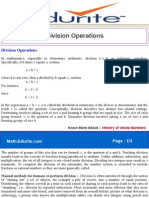Even Numbers
Even Numbers
Uploaded by
api-174391216Copyright:
Available Formats
Even Numbers
Even Numbers
Uploaded by
api-174391216Original Title
Copyright
Available Formats
Share this document
Did you find this document useful?
Is this content inappropriate?
Copyright:
Available Formats
Even Numbers
Even Numbers
Uploaded by
api-174391216Copyright:
Available Formats
Even Numbers
Even Numbers
This concept begins with integers. An even number is an integer that is "evenly divisible" by 2, i.e., divisible by 2 without remainder; an odd number is an integer that is not evenly divisible by 2. (The old-fashioned term "evenly divisible" is now almost always shortened to "divisible".) A formal definition of an even number is that it is an integer of the form n = 2k, where k is an integer; it can then be shown that an odd number is an integer of the form n = 2k + 1. Examples of even numbers are 4, 0, 8, and 1734. Examples of odd numbers are 5, 3, 9, and 71. This classification only applies to integers, i.e., non-integers like 1/2 or 4.201 are neither even nor odd. The sets of even and odd numbers can be defined as following: A number (i.e., integer) expressed in the decimal numeral system is even or odd according to whether its last digit is even or odd. That is, if the last digit is 1, 3, 5, 7, or 9, then it is odd; otherwise it is even. The same idea will work using any even base. In particular, a number expressed in the binary numeral system is odd if its last digit is 1 and even if its last digit is 0. In an odd base, the number is even according to the sum of its digits it is even if and only if the sum of its digits is even. The following laws can be verified using the properties of divisibility. They are a special case of rules in modular arithmetic, and are commonly used to check if an equality is likely to be correct by testing the parity of each side. Know More About :- Whole Numbers Basics
Math.Edurite.com
Page : 1/3
Addition and subtraction odd even = odd; Rules analogous to these for divisibility by 9 are used in the method of casting out nines. Multiplication even even = even; even odd = even; odd odd = odd. Division The division of two whole numbers does not necessarily result in a whole number. For example, 1 divided by 4 equals 1/4, which is neither even nor odd, since the concepts even and odd apply only to integers. But when the quotient is an integer, it will be even if and only if the dividend has more factors of two than the divisor. The ancient Greeks considered 1 to be neither fully odd nor fully even. Some of this sentiment survived into the 19th century: Friedrich Wilhelm August Frbel's 1826 The Education of Man instructs the teacher to drill students with the claim that 1 is neither even nor odd, to which Frbel attaches the philosophical afterthought, It is well to direct the pupil's attention here at once to a great far-reaching law of nature and of thought. It is this, that between two relatively different things or ideas there stands always a third, in a sort of balance, seeming to unite the two. Thus, there is here between odd and even numbers one number (one) which is neither of the two. Similarly, in form, the right angle stands between the acute and obtuse angles; and in language, the semi-vowels or aspirants between the mutes and vowels. A thoughtful teacher and a pupil taught to think for himself can scarcely help noticing this and other important laws.[
Read More About :- Whole Number Addition
Math.Edurite.com
Page : 2/3
ThankYou
Math.Edurite.Com
You might also like
- SANS 10144 Detailing CodeDocument155 pagesSANS 10144 Detailing CodepreneshthulsiNo ratings yet
- Operations Management - Problems & SolutionsDocument3 pagesOperations Management - Problems & SolutionsMaidhily Govind75% (12)
- 120 NicomachusDocument13 pages120 Nicomachusdavid.contatos4308No ratings yet
- The Number Concept, True its Definition and The Division by ZeroFrom EverandThe Number Concept, True its Definition and The Division by ZeroNo ratings yet
- 1 PPTMDocument10 pages1 PPTMsalihdst0No ratings yet
- Rational and Irrational NumbersDocument8 pagesRational and Irrational NumbersManal KolouiNo ratings yet
- Mathematics Investigatory Project: Irrational and Rational NumbersDocument16 pagesMathematics Investigatory Project: Irrational and Rational NumbersRichlie Natividad100% (2)
- Unit 1 Real NumbersDocument17 pagesUnit 1 Real NumberslumaromartinNo ratings yet
- What Are Prime NumbersDocument4 pagesWhat Are Prime Numbersapi-150547803No ratings yet
- Second Lecture Math100Document15 pagesSecond Lecture Math100Thích Toán HọcNo ratings yet
- Prime NumbersDocument4 pagesPrime Numbersapi-150547803No ratings yet
- Prime NumbersDocument3 pagesPrime Numbersapi-174391216No ratings yet
- Quantitative Aptitude - Vol 1Document189 pagesQuantitative Aptitude - Vol 1Ruby Sheela100% (2)
- NumbDocument25 pagesNumbZulkifli Paldana AkbarNo ratings yet
- Prime NumberDocument3 pagesPrime Numberapi-174391216No ratings yet
- Number SystemDocument74 pagesNumber SystemKrishna SilNo ratings yet
- Algebra - BoundlessDocument784 pagesAlgebra - BoundlessklingonNo ratings yet
- Math Lecture 1Document12 pagesMath Lecture 1Leo AnimeNo ratings yet
- History of Rational NumbersDocument4 pagesHistory of Rational Numbersnishagoyal40% (5)
- Multiples Factors and PowersDocument38 pagesMultiples Factors and PowersFaist Name Last NameNo ratings yet
- VND Openxmlformats-Officedocument PresentationmlDocument10 pagesVND Openxmlformats-Officedocument Presentationmlsalihdst0No ratings yet
- GE 4 Chapter 2 NotesDocument6 pagesGE 4 Chapter 2 NotesRonnie Francisco ToribioNo ratings yet
- Rational and Irrational NumbersDocument4 pagesRational and Irrational NumbersnishagoyalNo ratings yet
- IntegersDocument3 pagesIntegersSchool Desk SpaceNo ratings yet
- MMW Notes PrelimDocument17 pagesMMW Notes PrelimTrixy AlmendraNo ratings yet
- Prelim - Lesson-3 - Language of Mathematics and SetsDocument76 pagesPrelim - Lesson-3 - Language of Mathematics and SetsJed Nicole AngonNo ratings yet
- The Real Number SystemDocument36 pagesThe Real Number SystemKalson UmpuNo ratings yet
- Module 1 Eed9Document22 pagesModule 1 Eed9Laika EnriquezNo ratings yet
- Chapter 3. Logic: A Brief HistoryDocument21 pagesChapter 3. Logic: A Brief HistoryBusran Salamah TNo ratings yet
- Identity Property of MultiplicationDocument3 pagesIdentity Property of Multiplicationapi-150539480No ratings yet
- Maths ProjectDocument8 pagesMaths ProjectSadaf BaraskarNo ratings yet
- The Nature of NumbersDocument16 pagesThe Nature of Numbersvampire88No ratings yet
- Lesson 5 Mathematical Expressions and SentencesDocument3 pagesLesson 5 Mathematical Expressions and SentencesPlacido BucyayNo ratings yet
- Module 2 Eed6Document22 pagesModule 2 Eed6Laika EnriquezNo ratings yet
- Math Lecture 2Document10 pagesMath Lecture 2Leo AnimeNo ratings yet
- Our Journey of Learning Mathematics Starts With Numbers. We Are All Familia - 20240210 - 154649 - 0000Document35 pagesOur Journey of Learning Mathematics Starts With Numbers. We Are All Familia - 20240210 - 154649 - 0000Dwyane CaliwanNo ratings yet
- 05 Theory Math Bca 1ST SemDocument4 pages05 Theory Math Bca 1ST SemroygungunNo ratings yet
- Types of Rational NumbersDocument4 pagesTypes of Rational NumbersnishagoyalNo ratings yet
- CountingDocument17 pagesCountingseptiana azizahNo ratings yet
- Paper of History of MathematicsDocument8 pagesPaper of History of MathematicsmaisarahNo ratings yet
- Real and Imaginary Numbers: Natural or Counting NumbersDocument89 pagesReal and Imaginary Numbers: Natural or Counting NumbersKHY FAGARAGANNo ratings yet
- New FractionDocument28 pagesNew FractionRasalyn Cericos ValoisNo ratings yet
- 1.1 RealnumbersDocument2 pages1.1 Realnumbersnkbuduma8493No ratings yet
- Difinisi Nombor Bukan NisbahDocument7 pagesDifinisi Nombor Bukan NisbahMinTanNo ratings yet
- Importance of Mathematics in The Natural World!Document5 pagesImportance of Mathematics in The Natural World!April BalsitaNo ratings yet
- Lesson 1 Number and SequencesDocument38 pagesLesson 1 Number and SequencesJaysa MercurioNo ratings yet
- Types and Nature of NumbersDocument8 pagesTypes and Nature of NumbersAbhishek RajNo ratings yet
- Number Theory 1. The Real Number System: M7 Class 5 NotesDocument13 pagesNumber Theory 1. The Real Number System: M7 Class 5 NotesnaNo ratings yet
- Probability 2Document115 pagesProbability 2michala5No ratings yet
- Prime Number: 1 Definition and ExamplesDocument16 pagesPrime Number: 1 Definition and ExamplesAakashParanNo ratings yet
- Real NumberDocument7 pagesReal NumberAnand SinghNo ratings yet
- Rev - 2 - Math - Systems of Numbers & ConversionDocument16 pagesRev - 2 - Math - Systems of Numbers & ConversionKristine Camille GodinezNo ratings yet
- Algebra - IntegersDocument5 pagesAlgebra - IntegersSchool Desk SpaceNo ratings yet
- 02 Theory Math 1ST Sem BcaDocument3 pages02 Theory Math 1ST Sem BcaroygungunNo ratings yet
- Guia de Math 16 de Julio QuintoDocument1 pageGuia de Math 16 de Julio Quintokaren Yisseth Suarez PalenciaNo ratings yet
- Real and Imaginary NumbersDocument13 pagesReal and Imaginary NumbersJeselica Anne Marie CastroNo ratings yet
- 2mathematical Expressions and SentencesDocument3 pages2mathematical Expressions and SentencesRonie mar Del rosarioNo ratings yet
- The Real Number SystemDocument32 pagesThe Real Number SystemviksoniNo ratings yet
- Real Numbers DefinitionDocument3 pagesReal Numbers Definitionapi-150539480No ratings yet
- 1.3-1 Basic MathematicsDocument7 pages1.3-1 Basic MathematicsRhea F. ParajesNo ratings yet
- What Really Are Real Numbers?: WWW - Math.ucla - Edu/ Twg/real - NumbersDocument4 pagesWhat Really Are Real Numbers?: WWW - Math.ucla - Edu/ Twg/real - Numberscarlos9leoNo ratings yet
- Algebraic Expressions and IdentitiesDocument3 pagesAlgebraic Expressions and Identitiesapi-174391216No ratings yet
- Operations of Rational NumbersDocument3 pagesOperations of Rational Numbersapi-174391216No ratings yet
- Rational Number PropertiesDocument3 pagesRational Number Propertiesapi-174391216No ratings yet
- Rational Number On A Number LineDocument3 pagesRational Number On A Number Lineapi-174391216No ratings yet
- Whole Number AdditionDocument3 pagesWhole Number Additionapi-174391216No ratings yet
- Properties of Rational NumberDocument3 pagesProperties of Rational Numberapi-174391216No ratings yet
- Rational Numbers in ExpressionsDocument3 pagesRational Numbers in Expressionsapi-174391216No ratings yet
- Hexadecimal Number SystemDocument3 pagesHexadecimal Number Systemapi-174391216No ratings yet
- Identity Property of Real NumbersDocument3 pagesIdentity Property of Real Numbersapi-174391216No ratings yet
- Whole Numbers BasicsDocument3 pagesWhole Numbers Basicsapi-174391216No ratings yet
- Circles and Its Related TermsDocument3 pagesCircles and Its Related Termsapi-174391216No ratings yet
- Binary NumbersDocument3 pagesBinary Numbersapi-174391216No ratings yet
- Binary ConversionDocument3 pagesBinary Conversionapi-174391216No ratings yet
- Circles and ConstructionDocument3 pagesCircles and Constructionapi-174391216No ratings yet
- Prime NumberDocument3 pagesPrime Numberapi-174391216No ratings yet
- De Moivre's TheoremDocument3 pagesDe Moivre's Theoremapi-174391216No ratings yet
- ReflectionDocument3 pagesReflectionapi-174391216No ratings yet
- Natural NumbersDocument3 pagesNatural Numbersapi-174391216No ratings yet
- Composite NumbersDocument3 pagesComposite Numbersapi-174391216No ratings yet
- Page: 1/3: What Is The LCM of 4 and 6?Document3 pagesPage: 1/3: What Is The LCM of 4 and 6?api-174391216No ratings yet
- Binary Number SystemsDocument3 pagesBinary Number Systemsapi-174391216No ratings yet
- Surface Area of A Cuboid and A CubeDocument3 pagesSurface Area of A Cuboid and A Cubeapi-174391216No ratings yet
- Binary Number SystemDocument3 pagesBinary Number Systemapi-174391216No ratings yet
- Vertically Opposite Angles DefinitionDocument3 pagesVertically Opposite Angles Definitionapi-174391216No ratings yet
- Prime NumbersDocument3 pagesPrime Numbersapi-174391216No ratings yet
- Linear Equation AlgebraDocument3 pagesLinear Equation Algebraapi-174391216No ratings yet
- Division OperationDocument3 pagesDivision Operationapi-174391216No ratings yet
- History of Whole NumbersDocument3 pagesHistory of Whole Numbersapi-174391216No ratings yet
- Angle Sum Property of A QuadrilateralDocument3 pagesAngle Sum Property of A Quadrilateralapi-174391216No ratings yet
- Division OperationsDocument3 pagesDivision Operationsapi-174391216No ratings yet
- Cobol QuizDocument62 pagesCobol QuizShankar RauniyarNo ratings yet
- EC8093 QB IQ - by WWW - EasyEngineering.net QB 2Document7 pagesEC8093 QB IQ - by WWW - EasyEngineering.net QB 2sankhasubhra mandalNo ratings yet
- Akash 1910004Document16 pagesAkash 1910004akNo ratings yet
- 3 Software RequirementsDocument41 pages3 Software RequirementsM KEERTHIKANo ratings yet
- Webm005001 - SK818-5 - SK820-5 TurboDocument272 pagesWebm005001 - SK818-5 - SK820-5 TurboFútbol y másNo ratings yet
- Assignment 2 DBM SDocument2 pagesAssignment 2 DBM SAbhishemNo ratings yet
- Organic Semiconductors: Fang-Chung Chen, National Chiao Tung University, Hsinchu, TaiwanDocument12 pagesOrganic Semiconductors: Fang-Chung Chen, National Chiao Tung University, Hsinchu, TaiwanTrần ChứcNo ratings yet
- Ux Triton 100 Spec 2.13Document1 pageUx Triton 100 Spec 2.13Tanya MathisNo ratings yet
- Circular MotionDocument13 pagesCircular MotionShakeel AhmadNo ratings yet
- Generator ClassDocument93 pagesGenerator ClassSam100% (8)
- Writing The Research TitleDocument3 pagesWriting The Research TitleJhimson CabralNo ratings yet
- Classification of Breast Cancer Histopathological Images Using Discriminative Patches Screened by Generative Adversarial NetworksDocument16 pagesClassification of Breast Cancer Histopathological Images Using Discriminative Patches Screened by Generative Adversarial NetworksGuru VelmathiNo ratings yet
- RF 95 WH LR sw915 PDFDocument2 pagesRF 95 WH LR sw915 PDFasepNo ratings yet
- Iit-Jee W MarkDocument20 pagesIit-Jee W MarkVikas KumarNo ratings yet
- Department of Computer Science and Engineering Coding Assignment For Deep Learning CSE754Document6 pagesDepartment of Computer Science and Engineering Coding Assignment For Deep Learning CSE754Rithvik ShettyNo ratings yet
- Table of ContentDocument13 pagesTable of Contentbijinder06No ratings yet
- Grade 8 Integrated Science - 2021 - Term 2Document237 pagesGrade 8 Integrated Science - 2021 - Term 2renatoelkot1978No ratings yet
- Integer Programming (IP) : Prof. Yong Won Seo (Seoyw@cau - Ac.kr) College of Business Administration, CAUDocument53 pagesInteger Programming (IP) : Prof. Yong Won Seo (Seoyw@cau - Ac.kr) College of Business Administration, CAUk leeNo ratings yet
- I. Learning ObjectiveDocument4 pagesI. Learning Objectivenorhanifah matanogNo ratings yet
- Techniques For Rendering Realistic Models in InventorDocument22 pagesTechniques For Rendering Realistic Models in InventormehdiNo ratings yet
- Experimental Determination of Double Vibe Function Parameters in Diesel Engines With BiodieselDocument12 pagesExperimental Determination of Double Vibe Function Parameters in Diesel Engines With BiodieselSteven DengNo ratings yet
- A Theory of Origami World PDFDocument46 pagesA Theory of Origami World PDFdawuNo ratings yet
- Sick EncoderDocument6 pagesSick EncoderUsman KhanNo ratings yet
- Settlement Analysis by Randolph MethodDocument2 pagesSettlement Analysis by Randolph MethodasdasNo ratings yet
- Me 5223 HW 03Document2 pagesMe 5223 HW 03Steven CullenNo ratings yet
- Antennas Terman McGraw Hill Engineering 1953Document566 pagesAntennas Terman McGraw Hill Engineering 1953Anderson GuiraoNo ratings yet
- Mgate 5105-Mb-Eip User'S Manual: Edition 6.0, March 2018Document67 pagesMgate 5105-Mb-Eip User'S Manual: Edition 6.0, March 2018Goran JovanovicNo ratings yet
- Buku Standarisasi Spek Mtu PLN - SK Dir 216 (Bus VT)Document1 pageBuku Standarisasi Spek Mtu PLN - SK Dir 216 (Bus VT)PontasNo ratings yet





